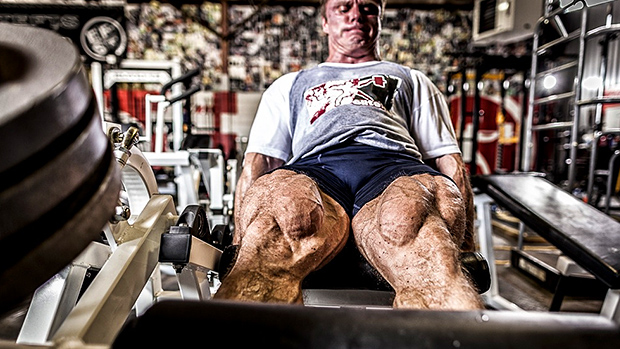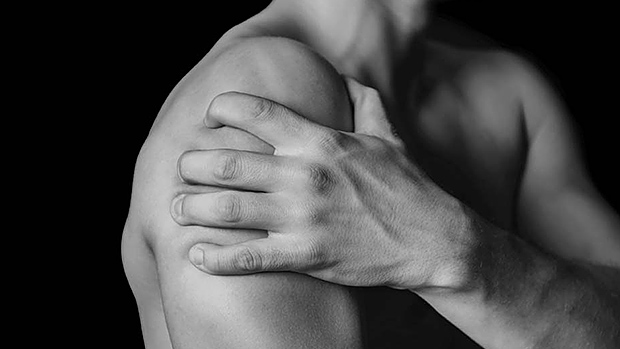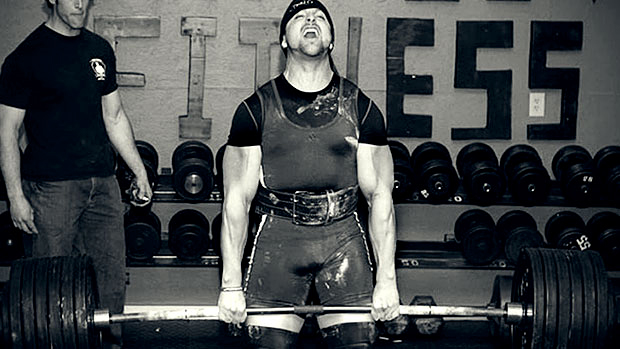I'm not a fan of lifters significantly arching their backs while bench pressing. This may tick off my powerlifting brethren, but I'm sticking with it.
First, let's be clear on the definitions. I'm a fan of a slight arch – lifting your chest, pulling the shoulder blades down and back, and having an anterior tilt in the pelvis. This "stand tall" position works well in the bench press as all you need to do is maintain that position as you lie back.
Excessive arching, on the other hand, is when you purposefully try to shorten the distance between your shoulder blades and your butt by attempting to make a downward facing horseshoe with your spine.
The excessive arch originated as a way to manipulate the rules, which in powerlifting state that the upper back and butt must be on the bench at all times.
The rules don't say anything specifically about the lower back touching the bench, which makes sense. Given the natural curve of the spine and the fact that people have glutes – powerlifters often more than their fair share – a lifter's lower back won't touch the bench unless he lifts his feet off the ground.
In short, it wasn't technically illegal to use a big arch. Since people like to win, the powerlifting big arch was born.
Now if one is competing in a powerlifting competition and the goal is to bench as much as possible, then by all means, arch away. But I still don't believe you should train with an arch very often; just enough to be comfortable with it come competition day.
And if that isn't you – if you're just an ordinary gym rat looking to get bigger and stronger – then lose the goal of replicating the St. Louis Arch with your spine.
First off, this position puts much more pressure on the lower back. When the spine is in extreme extension, the discs and nerves are at a greater risk of injury.
Granted, the spine isn't loaded in the traditional sense during a bench press as it is during a squat, but there's still a lot of weight coming down, and assuming the legs are also driving up, some of these forces will meet in the spine.
Don't believe me? Have someone with a hurt back try to excessively arch while benching – their back pain flares up almost immediately.
Second, someone very concerned with their bench is likely a powerlifter, and most powerlifters are also squatting and deadlifting regularly, which places considerable stress on the spine. Since the musculature of the lower back is already somewhat slow to heal, that bench day in the program that you thought was a "rest" day for the core and lower body may not be much of a rest day after all.
Arching the back decreases the range of motion, thereby making the exercise easier and allowing a lifter to lift more weight. The downside is the muscles aren't challenged through their full ROM, so the muscle building potential is diminished.
How so? The more a muscle is stretched during the exercise, the more it responds to training. Just like how the decline press doesn't do as good a job building the pecs and shoulders as a flat bench press, a high arch bench has similar downfalls.
Partials and limited range reps are okay as a supplemental movement but they should not be your main movement all the time. You're only limiting your growth potential. This is important for all lifters, but especially beginners or early intermediates.
Admittedly, adjusting from "practice" mode to "competition" mode can be tricky, but if you bench 150 pounds with normal form and 185 with an extreme arch, I'd still recommend benching in training with a normal arch. The logic is, as the normal bench goes up, so will the arched bench – the inverse isn't necessarily true!
Sure, that 150-pound bencher may get to 250 pounds quicker with a big arch versus a non-archer, but he could easily hit a wall and have a very tough time getting past it.
One of the great things about barbells is that they transfer reasonably well to anything involving a moderate to high level of strength. Squats make you at least decent at almost any exercise in the gym involving the lower body, and the bench press generally does the same for the upper body.
However, if your bench press is only awesome when you arch like a contortionist and is much less with normal technique, that ability will not transfer well to other activities, either in the gym and on the field.
This is one reason why Charles Poliquin favors the close-grip bench as a measure of strength. Along with having a greater transference to what athletes do in sports, the close-grip bench press has less room for tricks like taking a super-wide grip or arching your back, both of which can embellish actual performance.
In other words, arching your back might take your bench from 210 pounds to 250 pounds, but since you'll never be able to get into that arch on the football field, that extra strength is basically lost.
Some refer to this as "fake" strength – yes, you lifted the weight, but considering the measures needed to do so, it has very little benefit in any context other than the bench press.
So yeah, it's cheating. Not technically cheating, because arching is still allowed, but that doesn't make it right.
Arching your back will also take away some leg drive. One way to arch your back is to get your feet behind your hips, but the farther the legs go back, the tougher it is to transfer leg drive into the bench without your butt leaving the bench.
Therefore, arch-lifters are substituting decreased ROM for less leg drive – but leg drive is likely to have a better transfer to other activities outside of the bench press!
Just in case I haven't ruffled enough feathers, leg drive in the bench press is also overrated. I'm not saying it isn't useful or important or that it can't help, it's just overrated.
It's good for an extra 10-20 pounds in most lifters – certainly significant, but not something that will take your 330-pound bench to 400 pounds, as some would have you believe.
This is clearly evidenced by the amazing para-Olympic bench presser Siamand Rahman, who benched 705 pounds recently – with non-functioning legs! That's just 10 pounds under the all time world record raw bench (tested or not) for able bodied athletes!
Here's a video of him doing 672 pounds:
Use good form on the bench press with a solid setup but don't attempt to get your upper back close to your butt. Train with normal form for the vast majority of your sets and save the big arch for truly maximum attempts.





